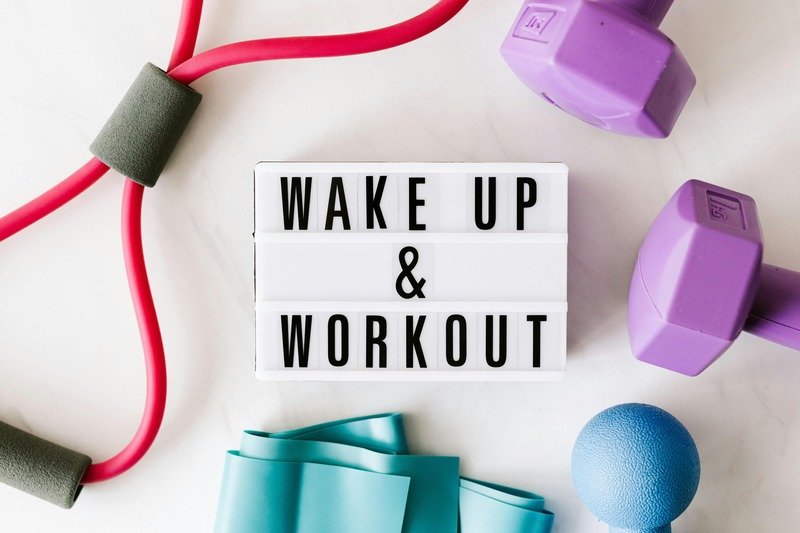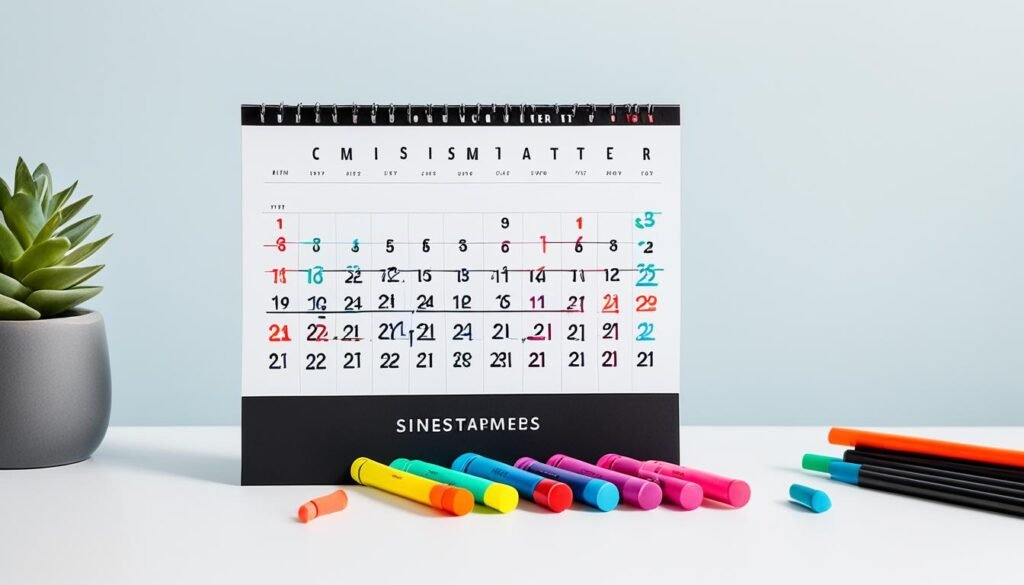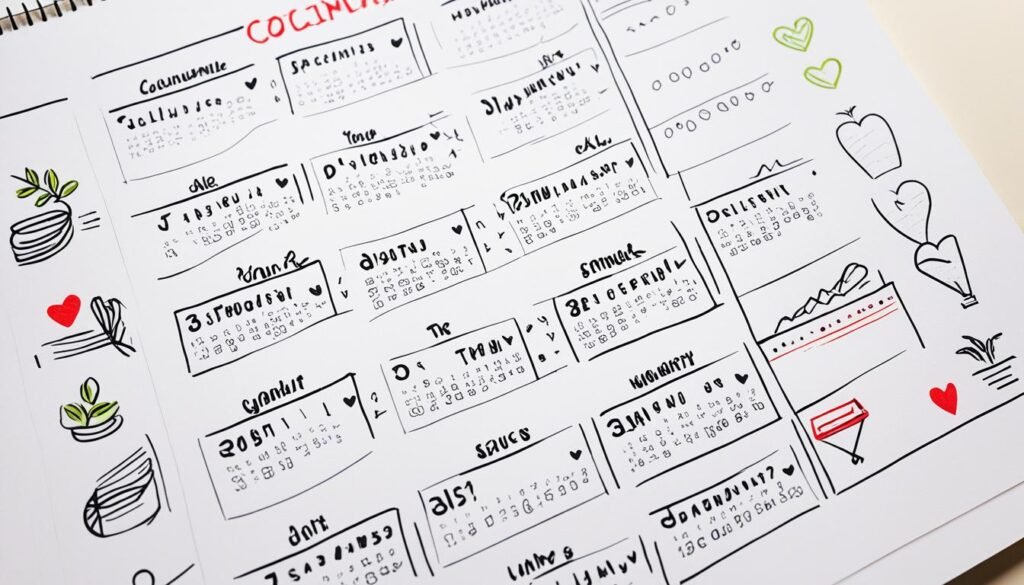We independently test and review fitness products using a research-based approach. If you buy through our links, we may earn a small commission at no extra cost to you. Read our Disclosure
Creating and sticking to a fitness schedule can be hard. It’s tempting to skip it, but the right moves can help you make it a part of your life. Treat workouts like important meetings. Make them a habit and don’t find excuses not to go. Try a 30-day commitment, start slowly, measure progress, and have someone to check in with. These tips will make it easier to work out regularly.

Having a consistent fitness routine is key for your health. Use these strategies daily to form a lasting habit of exercising. It may be tough at first, but the benefits are huge. Stay committed for a better and healthier you.
Create a Ritual
To start a new workout ritual, make it part of your daily routine. Doing this, exercise fits naturally in your life. It helps build exercise habits deeply rooted in your lifestyle.
It’s said a new habit takes about 66 days to stick. Begin with the “5/5/5” plan – 5 minutes of stretching, strength, and cardio each. Do this before 6 a.m. As it gets easier, make it 10/10/10 and move that start time back to 5:30 a.m.
Add exercise to your morning with meditation and reading. Spend 20 minutes on exercise, mindfulness, and self-improvement. Later, during lunch, 30 minutes should involve eating and walking outside to refresh.
In the evening, prepare for sleep by avoiding screens before bed. Their blue light messes with your sleep hormone. Instead, read, write, or do something calming to signal bedtime to your brain.
Make your workout ritual blend smoothly with your day. This way, it becomes something you enjoy, not a task. Test different routines and mark any success as you go.

Mark it on Your Calendar
Keeping up with fitness is easier when you treat your workouts seriously. Think of them like important appointments and schedule them in your calendar. Just like you’d never skip a key meeting or your child’s game, make sure your fitness schedule is a priority too.
Adding your workouts to your calendar means you won’t forget or double-book them. This ensures that your fitness goals stay at the top of your to-do list. By doing this, you show that you’re really committed to staying fit.
- Treat your workouts like any other important appointment or commitment.
- Schedule your workouts in your calendar, just like you would for a meeting or event.
- View your workout schedule as non-negotiable, and protect that time slot in your day.
- Set reminders for your workouts to ensure you don’t forget or double-book them.
- Review your weekly calendar regularly and adjust your workout schedule as needed to accommodate other priorities.
If you prioritize your fitness and scheduling your workouts, you’ll build a solid fitness habit. This approach keeps you focused, making your health a top concern.

| Statistic | Value |
|---|---|
| Percentage of adults in the U.S. who exercised for at least 30 minutes three times a week in 2016 | 53.4% |
| Recommended weekly exercise time by the U.S. Department of Health and Human Services | 150 minutes of moderate-intensity exercise or 75 minutes of high-intensity exercise |
| Increase in chances of sticking with a fitness plan by having an accountability partner | 10 times |
Commit for 30 Days
Building a consistent exercise habit needs time and effort. It’s said to take about 21-30 days to start a new habit. This makes a 30-day fitness challenge very helpful for starting a workout routine that lasts.
Joining a 30-day exercise program is more than just seeing quick changes. You’re teaching yourself and your body to live fit. If you stay on track, even when it gets tough, working out will just be something you do every day.
The Power of 30 Days
Many studies show that being consistent is how you really build lasting exercise habits. Doing a 30-day challenge means you’ll see these good changes:
- More confidence and willpower after each exercise
- Feeling more joyful and energized
- Getting more fit and healthier overall
- Creating a routine that’s easier to stick to over time
What matters is starting this challenge with focus and a good attitude. Cheer for your small wins, and it’s okay if you slip up a day or two. The aim is to build a healthy habit that stays with you for longer.
So, if you’re ready for a healthier, more engaging life, commit to a 30-day fitness challenge. You’ll see how easily exercise fits into your days.
Start Small
When you begin a beginner workout routine, start slow. Don’t jump into intense workouts right away. It’s better to start with two or three days each week. This lets your body get used to the movements and avoids getting tired or hurt.
As your body gets stronger and used to the exercises, increase how often and how hard you work out.
Adults should aim for at least 150 minutes of moderate exercise every week. This could be swimming or brisk walking. You can also do 75 minutes of intense activities, like running. Strength training, such as lifting weights, should be done at least two days a week to keep your muscles strong.
When you’re new to working out, add no more than 10% to your routine each week. This slow increase is better for your body. It helps prevent injuries and makes sure you keep exercising long term.
| Recommendation | Moderate Aerobic Activity | Vigorous Aerobic Activity | Strength Training |
|---|---|---|---|
| Weekly Minimum | 150 minutes | 75 minutes | 2 or more sessions |
| Weekly Increase | No more than 10% | No more than 10% | No more than 10% |
Building a strong beginner workout routine starts with small steps. Increase your workouts slowly. Focus on making exercise a regular part of your life. This will help you reach your fitness goals and stay healthy for life.

Effective Strategies for Creating a Consistent Fitness Schedule
Making a consistent fitness routine can be tough. To reach your health goals, it’s key. We’ve talked about creating a ritual, using a calendar, and starting small. Now, let’s look at more ways to make working out a part of your life.
One big hurdle is making excuses not to exercise. It’s common to find reasons to skip your workout. But, to make fitness a lifelong habit, you must beat these barriers. Remember, work, family, or feeling unmotivated are usual culprits. Identifying and tackling these reasons is important.
Keeping track of your progress is powerful. It keeps you pumped by showing how far you’ve come. You can use a fitness journal or an app to record and review your workouts.
- Avoid making excuses for not working out
- Track your progress to stay motivated and accountable
- Find an accountability partner to provide motivation and support
Having an accountability partner could really change the game. They can be a workout buddy or someone who checks on your fitness goals. This support and motivation are even easier to find today, with online communities.
| Strategy | Benefit |
|---|---|
| Avoid making excuses | Overcome obstacles and turn your fitness routine into a lifelong habit |
| Track your progress | Stay motivated and celebrate your successes |
| Find an accountability partner | Receive motivation and support to stick to your routine |
These strategies can boost your commitment to fitness. They will help you stick with your exercise routine and see lasting success.

Don’t Make Excuses
One of the hardest things about exercising regularly is coming up with reasons not to. It’s easy to say you’re too busy, too tired, or on a break. But, if you want to stay fit for life, ditching those excuses is key.
Even if you’re on the go or feeling unwell, you can find ways to be active. Making exercise a must, and not letting excuses get in the way, is vital. This helps you stick to a steady routine of keeping fit.
Stop the Excuses
Excuses keep us from staying fit. It’s high time we beat them and put our health first. Here are ways to avoid the excuse trap:
- Schedule your workouts in advance and treat them like important appointments.
- Have a backup plan ready in case of unexpected obstacles, such as an if-then strategy.
- Think about how good you feel and look after exercising, not about the effort.
- Make your workouts fun by trying new things or bundling them with tempting activities.
- Get a workout buddy to cheer you on and help you stay with it.
Building a routine and sticking to it is crucial for lifelong fitness. By not making excuses and keeping at it, you’re on your way to success. Keep it up!

Track Progress
Keeping track of your fitness tracking and exercise progress is key to staying fit. By noting your progress, you get insights. These insights can push you forward and help tweak your fitness plan. Motivation through progress is vital for lasting success.
Record your progress with a fitness tracker, an app, or a journal. These tools let you track key things like strength, endurance, and size changes. Watching these improvements helps keep you going, especially on tough days.
Finding areas to improve is easier when you keep track. If you hit a wall in your progress, the data can show why. This helps you fix your routine and keep moving forward.
Here are some tips for better tracking:
- Set SMART Goals: Pick clear goals that are specific, measurable, achievable, relevant, and time-bound.
- Take Regular Measurements: Keep track of changes in your weight, body fat, and size.
- Log Your Workouts: Write down what exercises you do and how much you lift to see gains over time.
- Take Progress Photos: Photos can show how your body changes through your hard work.
- Celebrate Milestones: Don’t forget to cheer yourself on as you hit different goals. It keeps you going.
| Metric | Initial | 30 Days | 60 Days | 90 Days |
|---|---|---|---|---|
| Weight | 150 lbs | 148 lbs | 145 lbs | 142 lbs |
| Body Fat % | 25% | 23% | 21% | 19% |
| Waist Circumference | 34 inches | 33 inches | 32 inches | 31 inches |
| Bench Press | 135 lbs | 145 lbs | 155 lbs | 165 lbs |
Keep up with your fitness tracking. It can motivate you, help you decide better, and meet your fitness dreams. Let tracking progress be your guide to the best fitness journey.
Find an Accountability Partner
Getting a workout partner helps you stay on track with your exercise. It’s all about the people we surround ourselves with. Knowing that someone else is in it with you can be a big push to keep going. This person can make sure you’re sticking to your fitness plan.
A workout partner can be the secret to reaching your exercise goals. You both agree on how to help each other. It works best when you set clear, achievable goals together. Making SMART goals (Specific, Measurable, Achievable, Relevant, and Time-bound) is a great idea. Goals like these help you win faster.
Talking with your fitness motivation buddy often is key. Choose how often based on what works for both of you. Texting, exercising online together, and sharing your workout stories help. Making sure you regularly catch up and review your progress is also important.
Strategies for Effective Accountability Partnerships
- Communicate your goals, target timelines, and weekly workout plans to your partner.
- Celebrate your milestones and minor wins along the way to maintain motivation.
- Adapt to asynchronous relationships if circumstances change, and be honest about the level of support you need.
- Consider ending partnerships that are no longer supportive or aligned with your fitness goals.
Choosing the right workout partner could change everything. By making use of the support and energy exercise accountability and fitness motivation bring, you can really push forward. This way, you’re staying true to your fitness resolutions and seeing real improvements.
Conclusion
Starting and sticking to a workout plan can be tough. But by using the right methods, it becomes doable. Make your workouts into a routine. Put them on your calendar. Promise yourself to stick with it for 30 days.
Start with small steps, and soon, exercise will be part of your everyday life. Keep away from excuses and measure your progress. Having someone to hold you accountable is a great help. It keeps you going.
Keep going every day, no matter how little, and you will see huge changes over time. These small daily efforts will pay off. Commit to these steps, and soon, a healthier life will be your reality.
Don’t get distracted. Be willing to change as needed, but not to quit. Always remember how far you’ve come. Putting your health first will help you reach your goals. Plus, it will bring you many other benefits.
Be excited about getting fitter and healthier. Stick to these strategies, and soon, you’ll be amazed at your progress. Stay determined. Let these steps lead you to a better, more active life.


